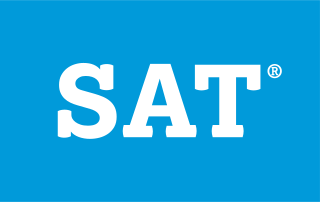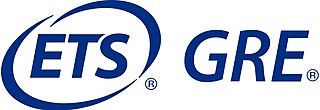
The SAT is a standardized test widely used for college admissions in the United States. Since its debut in 1926, its name and scoring have changed several times. For much of its history, it was called the Scholastic Aptitude Test and had two components, Verbal and Mathematical, each of which was scored on a range from 200 to 800. Later it was called the Scholastic Assessment Test, then the SAT I: Reasoning Test, then the SAT Reasoning Test, then simply the SAT.

A law school in the United States is an educational institution where students obtain a professional education in law after first obtaining an undergraduate degree.

Harvard College is the undergraduate college of Harvard University, a private Ivy League research university in Cambridge, Massachusetts, United States. Part of the Faculty of Arts and Sciences, Harvard College is Harvard University's traditional undergraduate program, offering AB and SB degrees. It is highly selective, with fewer than four percent of applicants being offered admission as of 2022.

The Graduate Record Examinations (GRE) is a standardized test that is part of the admissions process for many graduate schools in the United States and Canada and a few other countries. The GRE is owned and administered by Educational Testing Service (ETS). The test was established in 1936 by the Carnegie Foundation for the Advancement of Teaching.

The Law School Admission Test is a standardized test administered by the Law School Admission Council (LSAC) for prospective law school candidates. It is designed to assess reading comprehension, analytical reasoning, and logical reasoning. The test is an integral part of the law school admission process in the United States, Canada, the University of Melbourne, Australia, and a growing number of other countries.

The Universities and Colleges Admissions Service is a charity and private limited company based in Cheltenham, Gloucestershire, England, which provides educational support services. Formed on July 27th, 1993 by the merger of the former university admissions system, Universities Central Council on Admissions and the former polytechnics admissions system, Polytechnics Central Admissions System, the company's main role is to operate the application process for British universities and colleges. The company is funded by fees charged to applicants and universities as well as advertising income.
The Free Application for Federal Student Aid (FAFSA) is a form completed by current and prospective college students in the United States to determine their eligibility for student financial aid.

The Marshall Scholarship is a postgraduate scholarship for "intellectually distinguished young Americans [and] their country's future leaders" to study at any university in the United Kingdom. It is widely considered one of the most prestigious scholarships for U.S. citizens, and along with the Fulbright Scholarship, it is the only broadly available scholarship available to Americans to study at any university in the United Kingdom.
Early decision (ED) or early acceptance is a type of early admission used in college admissions in the United States for admitting freshmen to undergraduate programs. It is used to indicate to the university or college that the candidate considers that institution to be their top choice through a binding commitment to enroll. Applying early decision brings a greater statistical chance of being accepted.
University admission or college admission is the process through which students enter tertiary education at universities and colleges. Systems vary widely from country to country, and sometimes from institution to institution.

Legacy preference or legacy admission is a preference given by an institution or organization to certain applicants on the basis of their familial relationship to alumni of that institution. It is most controversial in college admissions, where students so admitted are referred to as legacies or legacy students. The practice is particularly widespread in the college admissions in the United States; almost three-quarters of research universities and nearly all liberal arts colleges grant legacy preferences in admissions.
Pre-medical is an educational track that undergraduate students in the United States pursue prior to becoming medical students. It involves activities that prepare a student for medical school, such as pre-med coursework, volunteer activities, clinical experience, research, and the application process. Some pre-med programs providing broad preparation are referred to as “pre-professional” and may simultaneously prepare students for entry into a variety of first professional degree or graduate school programs that require similar prerequisites.
College application is the process by which individuals apply to gain entry into a college or university. Although specific details vary by country and institution, applications generally require basic background information of the applicant, such as family background, and academic or qualifying exam details such as grade point average in secondary school and standardized testing scores.

College admissions in the United States refers to the process of applying for entrance to institutions of higher education for undergraduate study at one of the nation's colleges or universities. For those who intend to attend college immediately after high school, the college search usually begins in the eleventh grade with most activity taking place during the twelfth grade. Applications to many schools are due in October or November of senior year for Early Decision or Early Action, or in December or January of their senior year for Regular Decision, though the timeline may vary depending on the universities, some having an earlier deadline due to the fact that the admissions process may weigh in more on transcripts. Students at top high schools may often begin the process during their tenth grade or earlier. There are considerable numbers of students who transfer from one college to another, as well as adults older than high school age who apply to college.

The Common Application is an undergraduate college admission application that applicants may use to apply to over 1,000 member colleges and universities in all 50 U.S. states and the District of Columbia, as well as in Canada, China, Japan, and many European countries.
Medical school in the United States is a graduate program with the purpose of educating physicians in the undifferentiated field of medicine. Such schools provide a major part of the medical education in the United States. Most medical schools in the US confer upon graduates a Doctor of Medicine (MD) degree, while some confer a Doctor of Osteopathic Medicine (DO) degree. Most schools follow a similar pattern of education, with two years of classroom and laboratory based education, followed by two years of clinical rotations in a teaching hospital where students see patients in a variety of specialties. After completion, graduates must complete a residency before becoming licensed to practice medicine.
CASPA or the Centralized Application Service for Physician Assistants is an application service for graduate-level PA programs. Similar to the Common Application used by some undergraduate institutions and the American Medical College Application Service used by medical schools, CASPA allows students to submit one application to multiple schools. The CASPA application platform is a service offered by the Physician Assistant Education Association (PAEA).

SAT Subject Tests were a set of multiple-choice standardized tests given by The College Board on individual topics, typically taken to improve a student's credentials for college admissions in the United States. For most of their existence, from their introduction in 1937 until 1994, the SAT Subject Tests were known as Achievement Tests, and until January 2005, they were known as SAT II: Subject Tests. They are still commonly known by these names. Unlike the Scholastic Aptitude Test (SAT) that the College Board offers, which are intended to measure general aptitude for academic studies, the Achievement Tests are intended to measure the level of knowledge and understanding in a variety of specific subjects. Like the SAT, the scores for an Achievement Test range from 200 (lowest) to 800 (highest).
The undergraduate education at the University of Oxford in England involves weekly tutorials at the colleges and halls, supported by classes, lectures and laboratory work provided by university faculties and departments.
Students for Fair Admissions v. Harvard, 600 U.S. 181 (2023), is a landmark decision of the Supreme Court of the United States in which the court held that race-based affirmative action programs in college admissions processes violate the Equal Protection Clause of the Fourteenth Amendment. With its companion case, Students for Fair Admissions v. University of North Carolina, the Supreme Court effectively overruled Grutter v. Bollinger (2003) and Regents of the University of California v. Bakke (1978), which validated some affirmative action in college admissions provided that race had a limited role in decisions.









